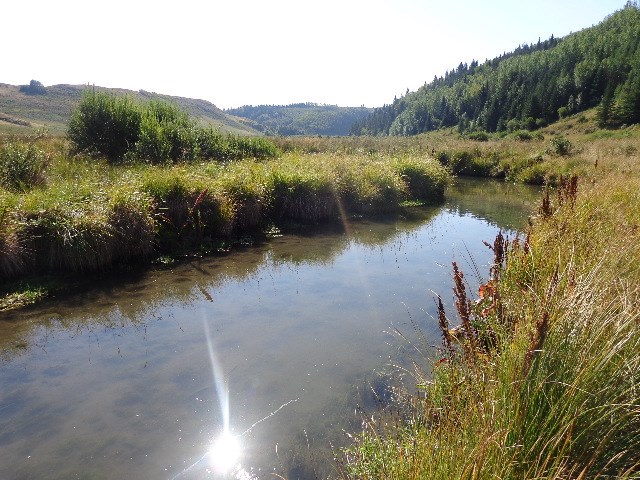Just about anyone with an interest in gravel mining or preservation of the BigHill Creek valley and nearby provincial park had a unique opportunity to have their “day in court” at a recent free public lecture sponsored by the Canadian Institute of Resources Law at the University of Calgary.
Dubbed ‘Saturday Morning at the Law School,’ the series of lectures has focused on hot topics in law such as Alberta Sovereignty within a United Canada Act: Overview and Implications; and Carbon Capture and Storage in Alberta: What are the Issues?
On Oct. 14, Dr. Judy Stewart, PhD, gave a presentation entitled: Alberta Law & the Potential Impacts of Gravel Extraction on the Fragile Ecosystem within Big Hill Springs Provincial Park. She moderated an expert panel discussion at the end of her presentation that took questions from the crowd.
The two-hour session was attended by a diverse group representing a variety of interests, including landowners, a hydrogeologist, a geologist, a member of the gravel industry, the BigHill Creek Preservation Society, law students, a professor from the Canadian Institute of Resources Law, and a First Nations member, among others.
Stewart, who has decades of experience in gravel pit issues and is a retired lawyer, has also spent time in the local political realm as mayor of Cochrane, so had previous knowledge of some of the issues surrounding Big Hill Springs Provincial Park.
“It is in the public interest to preserve the park for future generations under the principles of sustainability where the economy, culture, the ecosystem and politics intertwine,” she said.
The Mountain Ash/Summit Pit, which is located over the aquifer that feeds the springs, has been approved by Rocky View County (RVC) and the province, under The Water Act.
Tako Koning, a professional geologist who lived and worked worldwide in the petroleum industry for over 40 years on oil, natural gas and water-bearing reservoirs, said Big Hill Springs Provincial Park is important because it is so unique.
“I am not anti-gravel. I recognize that gravel and cement is of critical importance to today’s economies. But the area all around Cochrane has huge deposits of gravel everywhere. It has gravel galore. But building a mega-gravel mine almost next door to a small, well-loved, and much visited provincial park with unique springs, well, that absolutely makes no sense whatsoever. In my view, it is not worth the risk,” he said.
A report in 1984 by Tera Environmental Consultants titled Natural History Study of Mineral and Thermal Springs in Canada rated the Big Hill spring the fourth most important mineral spring in Canada.
The focus of much discussion recently is the area on Highway 567 just north of Cochrane, where one pit (Hillstone) currently operates, one (Mountain Ash) is stripping surface material, and three more are planned, all of them basically butting up against each other.
There are two challenges underway with different provincial government bodies aimed at stopping or at least delaying operations at the pits at least until the results of a tribunal (McNair) and an appeal (Mountain Ash) are rendered.
“The technology emerges faster than the law can change,” she said. “So what happens is we have laws requiring certain technology, but it has become obsolete, but that is still the standard applied when applications are reviewed.”
Stewart cited technical information provided by consultants for the pit owners as well as some of the issues raised by opponents. She focussed on legal issues, including the application process, how Water Act approvals work, potential ecosystem impacts, and the status of the Mountain Ash appeal.
An example of one of the more arcane legal issues involved in gravel mining is the debate around who may be defined as “directly affected” by the operation of the pits. It’s just one example of the many esoteric legal challenges involved, as it affects who will be allowed to present information to the various regulatory and appeals bodies.
One of Stewart’s slides featured a key question that would need to be answered in the Mountain Ash appeal, namely, “. . . did the (province) fail to consider and address the potential direct, indirect, and cumulative adverse effects of the activity on the underlying Paskapoo aquifer, the springs in Big Hill Springs Provincial Park, and the aquatic ecosystem (the water bodies, wetlands and riparian lands) of the Big Hill Creek watershed?”
Other gravel pits – there could end up being as many as five – operate or plan to operate close by with potential cumulative adverse effects on surface and groundwater. These potential adverse effects have been identified by professional geochemists and hydrogeologists familiar with the watershed’s lands, water and vegetation.
Gravel mining proponents and opponents each bring their own technical experts to the table to weigh in during the application and appeals processes.
And their own lawyers.
After a slide outlining the merits of the appeal (including references to relevant case law), and another titled ‘Likelihood of Success?’ those in attendance leaned forward as they may have anticipated an expert assessment of whether the board will side with them or not.
Stewart may have disappointed those looking for some free legal advice, but they were left laughing as she punched in a command on her laptop that popped up a thought balloon on screen that said, “Do you think I am crazy?”
It was a lighthearted way to emphasize the difficulty in making a prediction within such a complex legal framework, with serious implications for landowners, gravel companies, and environmental groups.
So for now, the jury is still out.




